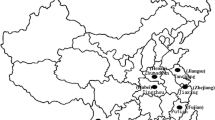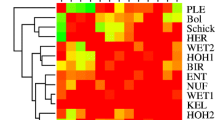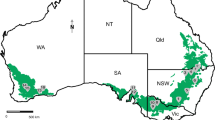Abstract
The ascomycete pathogen Ramularia collo-cygni causes Ramularia leaf spot (RLS) on barley. Although R. collo-cygni is considerd an emerging disease of barley, little is known about genetic diversity or population genetic structure of this pathogen. We applied a set of polymorphic AFLP (Amplified Fragment Length Polymorphism) markers to investigate population genetic structure in two Northern European populations of R. collo-cygni. The distribution of AFLP alleles revealed low levels of population subdivision and high levels of genetic diversity at both locations. Our analyses included 87 isolates and of these 84 showed a unique genotype pattern. The genetic structure of populations in Scotland and Denmark is highly similar and we find no evidence of population sub-division. An analysis of molecular variance was used to show that 86 % of the variance is attributable to within field genetic variance. In spite of the high levels of genetic and genotypic diversity in the R. collo-cygni populations, we find significant evidence of linkage disequilibrium among the AFLP alleles using a multilocus analysis. We propose that the high levels of genotypic diversity and the lack of population differentiation result from considerable levels of gene flow between populations most likely mediated by seed borne dispersal of inoculum.




Similar content being viewed by others
References
Agapow, P. M., & Burt, A. (2001). Indices of multilocus linkage disequilibrium. Molecular Ecology Notes, 1, 101–102.
Cavara, F. (1893). Zeitschrift für Pflanzenkrankheiten, 3, 16–19.
Christiansen, M. J., Feenstra, B., Skovgaard, I. M., & Andersen, S. B. (2006). Genetic analysis of resistance to yellow rust in hexaploid wheat using a mixture model for multiple crosses. Theoretical and Applied Genetics, 112, 581–591.
Eriksen, L., Shaw, M. W., & Østergård, H. (2001). A model of the effect of pseudothecia on genetic recombination and epidemic development in populations of Mycosphaerella graminicola. Phytopathology, 91, 240–248.
Garcia-Vallvè, S., Palau, J., & Romeu, A. (1999). Horizontal gene transfer in glycosyl hydrolases inferred from codon usage in Escherichia coli and Bacillus subtilis. Molecular Biology and Evolution, 16, 1125–1134.
Greif, P. (2002). Importance of leaf spot Ramularia collo-cygni for barley growers and breeders. Meeting the challenges of barley blights. Proceedings of the II international workshop on barley leaf blights, 7–11.
Halama, P. (2002). Mating relationships between isolates of Phaeosphaeria nodorum, (anamorph Stagonospora nodorum) from geographical locations. European Journal of Plant Pathology, 108, 593–596.
Harvey, I. (2002). Epidemiology and control of leaf and awn spot of barley caused by Ramularia collo-cygni. New Zealand Plant Protection, 55, 331–335.
Leisova-Svobodova, L., Matusinsky, P., & Kucera, L. (2012). Variability of the Ramularia collo-cygni population in Central Europe. Journal of Phytopathology, 160, 701–709.
Linde, C. C., Zala, M., & McDonald, B. A. (2009). Molecular evidence for recent founder populations and human-mediated migration in the barley scald pathogen Rhynchosporium secalis. Molecular Phylogenetics and Evolution, 51, 454–464.
Matusinsky, P., Leisova-Svobodova, L., Marik, P., Tvaruzek, L., Stemberkova, L., Hanusova, M., Minarikova, V., Vysohlidova, M., & Spitzer, T. (2011). Frequency of a mutant allele of cytochrome b conferring resistance to QoI fungicides in the Czech population of Ramularia collo-cygni. Journal for Plant Diseases and Plant Protection, 6, 248–252.
McDonald, B. A., & Linde, C. (2002). Pathogen population genetics, evolutionary potential, and durable resistance. Annual Review of Phytopathology, 40, 349–379.
Mueller, U., & Wolfenbarger, L. (1999). AFLP genotyping and fingerprinting. Trends in Ecology & Evolution, 14, 389–394.
Nei, M. (1973). Analysis of gene diversity in subdivided populations. Proceedings of the National Academy of Sciences, 70, 3321–3323.
Nei, M. (1978a). Estimation of average heterozygosity and genetic distance from a small number of individuals. Genetics, 89, 583–590.
Nei, M. (1978b). The theory of genetic distance and evolution of human races. Journal of Human Genetics, 23, 341–369.
Peakall, R., & Smouse, P. E. (2006). GENALEX 6: genetic analysis in Excel. Population genetic software for teaching and research. Molecular Ecology Notes, 6, 288–295.
Peakall, R., Smouse, P. E., & Huff, D. R. (1995). Evolutionary implications of allozyme and RAPD variation in diploid populations of dioecious buffalograss Buchloë dactyloides. Molecular Ecology, 4, 135–147.
Rau, D., Maier, F. J., Papa, R., Brown, A. H. D., Balmas, V., Saba, E., Schaefer, W., & Attene, G. (2005). Isolation and characterization of the mating-type locus of the barley pathogen Pyrenophora teres and frequencies of mating-type idiomorphs within and among fungal populations collected from barley landraces. Genome, 48, 855–869.
Sachs, E. (2006). The history of research into Ramularia leaf spot on barley. Proceedings of the 1st European Ramularia Workshop, Göttingen. Germany, 9–15.
Schützendübel, A., Stadler, M., Wallner, D., & Von Tiedemann, A. (2008). A hypothesis on physiological alterations during plant ontogenesis governing susceptibility of winter barley to ramularia leaf spot. Plant Pathology, 57, 518–526.
Stabentheiner, E., Minihofer, T., & Huss, H. (2009). Infection of barley by Ramularia collo-cygni: scanning electron microscopic investigations. Mycopathologia, 168, 135–143.
Vos, P., Hogers, R., Bleeker, M., Reijans, M., van de Lee, T., Hornes, M., Friters, A., Pot, J., Paleman, J., Kuiper, M., & Zabeau, M. (1995). AFLP: a new technique for DNA fingerprinting. Nucleic Acids Research, 23, 4407–4414.
Walters, D. R., Havis, N. D., & Oxley, S. J. (2008). Ramularia collo-cygni: the biology of an emerging pathogen of barley. FEMS Microbiology Letters, 279, 1–7.
Zaffarano, P. L., McDonald, B. A., & Linde, C. C. (2009). Phylogeographical analyses reveal global migration patterns of the barley scald pathogen Rhynchosporium secalis. Molecular Ecology, 18, 279–293.
Zhan, J., Kema, G. H. J., Waalwijk, C., & McDonald, B. A. (2002). Distribution of mating type alleles in the wheat pathogen Mycosphaerella graminicola over spatial scales from lesions to continents. Fungal Genetics and Biology, 36, 128–136.
Acknowledgments
Sejet Plantbreeding I/S, Denmark funded the population genetic study of R. collo-cygni and a PhD fellowship to RLH.
Author information
Authors and Affiliations
Corresponding author
Rights and permissions
About this article
Cite this article
Hjortshøj, R.L., Ravnshøj, A.R., Nyman, M. et al. High levels of genetic and genotypic diversity in field populations of the barley pathogen Ramularia collo-cygni . Eur J Plant Pathol 136, 51–60 (2013). https://doi.org/10.1007/s10658-012-0137-8
Accepted:
Published:
Issue Date:
DOI: https://doi.org/10.1007/s10658-012-0137-8




